10

Geezers of Nazareth
Egypt was the perennial storehouse of occult and pagan spiritual ideas long forbidden in Jewish religion, so much so that, according to one early tradition, when John the Baptist returned from there charged with a prophetic mission offering self-discovery, his path was regularly impeded by temple authorities in Judea.
After a period of seclusion in the wilderness to discover himself, John returned to a working life in Bethesda and advised new candidates to “prepare for The Way.” His ritual baptisms—an initial component on the path to living resurrection—offered liberation to a populace long excluded from contact with gnosis by a conservative religious establishment. To orthodox keyholders what John was doing was nothing short of scandalous, and yet to the masses, the Baptist’s message rang a bell because the faith he professed was nothing new, in fact it was a return to an older, outlawed practice.
Fortunately the establishment’s censoring did not entirely succeed. His followers went on to become the Mandeans who, despite ongoing Christian persecution, still survive to this day as the Natzoraje in southern Iraq, along with their most prized possession, the Book of John, the gospel of their preeminent spiritual teacher. As we saw earlier, the Mandean ritual incorporated the bridal chamber, as well as a particular emphasis on flowing or living water during baptism. Only two adepts of the Mysteries are known to have used this technique—one was John the Baptist.
The other was Jesus. For a guy who inspired a centralized religious movement, albeit without his consent, little is known about him, and even that little is a lot misunderstood. For centuries the church has tried to paint him as an itinerant Mediterranean peasant who heralded from Nazareth, and yet neither the city nor the synagogue depicted in Christian scripture actually existed at the time. The entire area appears to have been a hamlet consisting of nothing more than a few hovels and former cave dwellings.1
In reality Jesus was far more than that. The Mandean texts categorically state that he broke away from John the Baptist’s school to fashion his own. This caused much consternation among the sect because they accused Jesus of openly teaching many of the Mandeans’ secret doctrines. However, his actions and esoteric teachings betray his true spiritual roots to not one singular creed but many, including the initiation methods of the house of Isis and Osiris.2 Jesus, like Osiris, even compares himself to “the bright and morning star,” referring to Venus.3
What is known is that in his later years Jesus belonged to a Gnostic brotherhood linked to both the Mandeans and the Essenes—the Nasurayi (‘guardians of secret rites and knowledge’), and their hometown was not Nazareth but Cochaba.4 Jesus’s unique methods of initiation indicate he’d once been a magus at the highest level of Mandean initiation, a position that carried the title nasoraiyi, and the way in which initiates came to adopt this title was through a rite of passage performed in a bridal chamber, after which they were officially qualified to administer that most secret of rites, the living resurrection.5
Persian magi actually regarded Jesus as the latest embodiment of Zoroaster, whom they saw as a reincarnating prophet who changes his name, form, and appearance through the ages on his voyage to master the secrets of nature. Jesus was claimed to be the thirteenth and final such incarnation.
A true Piscean, Jesus was born on March 1. The mere mention of this heresy is sure to have your name struck from every dinner party hosted by latter-day Christians. But your days in societal purgatory will be compensated by the joy of knowing that even the medieval church was aware of this fact, and only in the fourth century was Jesus awarded a birth date wedded to the winter solstice. At the time, the reason was a practical one: wishing to corral pagans into this new religion, the emperor Constantine—a worshipper of Mithras—took the celebration of Jesus and amalgamated it with a goodly number of pagan traditions of gods who regenerated themselves around the time of the winter solstice—Apollo, Dyonisus, Adonis, Attis, Tammuz—but especially Mithras, a god-man whose birth in a cave was attended by shepherds, and who took a last supper before undergoing a ritual death.
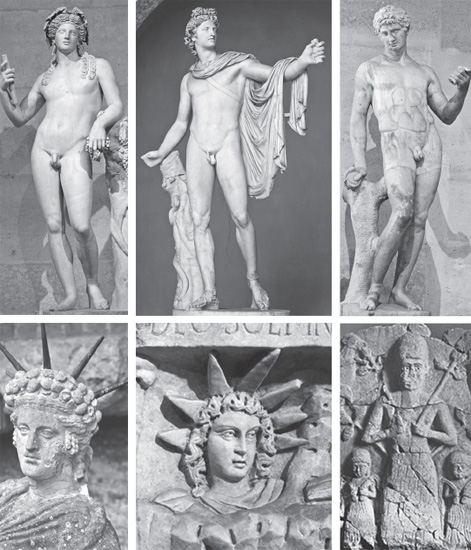
Definitely BC: the resurrected gods Dyonisus, Apollo, Adonis, Attis, Mithras, Tammuz.
OSIRIS AND JESUS, SEPARATED AT BIRTH
Not forgetting, of course, Osiris, whose dismembered body is restored by his consort, Isis, to reemerge three days after the winter solstice as Horus, the infant who sits on the lap of Isis—later transferred into Christian imagery as the god-child Jesus sitting on the lap of Mary.
Let us now come full circle to the solar hero—the candidate who undertakes a figurative death, is awakened to the Great Mystery, and returns from the Otherworld transfigured as a bright star. Gnostic sects wholeheartedly believed in living resurrection as a tool for self-discovery, and initiates who mastered it were described as the Great Illuminated. In doing so they took their place alongside the lineage of priest-kings of the Neolithic era, the Horus pharaohs and sun kings—truly awakened heroes deserving the epithet Sons of God.
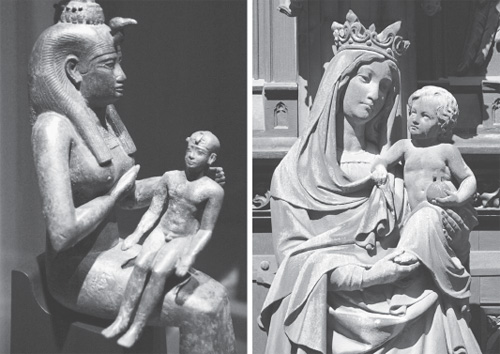
The Divine Virgin, in her many guises.
In reality, to be proclaimed a Son of God is to disclose one’s highest grade of initiation. In the language of the temple, the neophyte carried the title ‘son of woman,’ followed by ‘son of man,’ from whence one graduated as an initiate of cosmogonic science to become a ‘son of the gods,’ culminating in total illumination, which came with the title ‘Son of God.’6
An original Son of God is Osiris, the hero who shed his material attachment to the body, mastered the Otherworld, transfigured his soul, resurrected as a bright star, and became like a god. Osiris is the very personification of the god-man. He is the hero of his personal ritual, and by way of a perk he also gets to preside over the entrance into Sekhet Aaru (‘field of reeds’), otherwise known as paradise.
Not surprisingly, Osiris becomes the role model for subsequent solar heroes, one of the most recent being Jesus Christ, which we now know to be not a real name but a symbolic Greek title, Iessous Christós, essentially meaning “I am an anointed man spiritualized by knowledge of God.” It’s an archetypal title for an initiate of the Mysteries who has learned to transmute their carnal nature into spiritual enlightenment and truly experienced the mind of God so as to understand the laws of celestial mechanics.
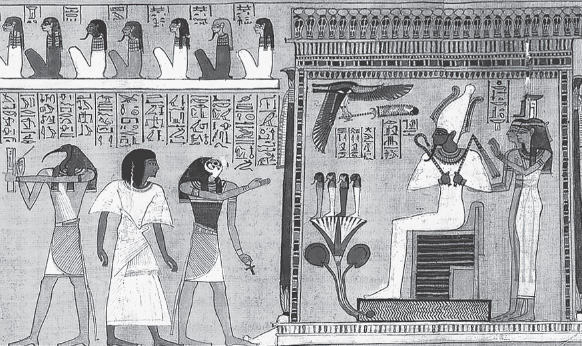
Osiris, guardian of the gate into Sekhet Aaru, or paradise.
If one reads the official gospels with an open mind, the events surrounding the death and subsequent resurrection of Jesus look highly dubious if taken literally. An accumulation of recent evidence overwhelmingly posits an alternate view: that he underwent a symbolic death followed by a living resurrection.7 Even the Qur‘an categorically states this and, as we already know, so do the Gnostic gospels.8 Read with a gnostic eye the story actually begins to make sense. In the lead-up to events, like all god-kings, Jesus is anointed with the expensive ointment spikenard by a priestess consecrated to the temple—in this case Mary Magdala9—in preparation for his ‘burial’ in a cave, in accordance with the rules of the bridal chamber ceremony. As Jesus states, “She has anointed my body beforehand for burying.”10 He’s the solar hero readying himself for a ritual death only to later rise from the dead, essentially performing an act of regicide commonly reenacted throughout history, and in the manner of the mystery play of Osiris.
There exists a second connection, this time a linguistic one, between the concept of Jesus as a christed human, the god-man Osiris, and the limestone plateau of Giza.
When expressing divinity on Earth in linguistic terms, the letter G is often prefixed to a name, as in Geb, Lord of Earth, and Gaia, the Earth Mother. In this respect the name Giza or Gisa is very revealing, named as it is for one of the oldest known expressions of Isis: Isa. By grounding her name, the Gisa plateau becomes ‘the earthly embodiment of Isis.’
Interestingly, Jesus in Arabic is also called Isa.
Giza in modern Egyptian also means ‘proximity’, implying that whatever is placed there is close to Isis. Since one of its man-made structures is the Great Pyramid—otherwise known as the House of Osiris—we are being told that this iconic temple and its inner chambers is a place where the sacred marriage is performed, where a mortal travels to the Otherworld as a single man, unites with the bride, and returns a god-man. Could this be why ancient Egyptians referred to the Great Pyramid as “the place of ascension”?
It could be argued, then, that Giza is a place of transformation, where a living human ascends, undergoes an alchemical transfiguration, and becomes like a god. The initiate is spiritualized and, like Jesus and so many other initiates, has risen from the dead.
It has been convincingly argued that young Jesus spent many of his formative years immersed in the Egyptian city of Alexandria, and if so this explains the font of so many of his esoteric ideas,11 not to mention why this period of his life is absent from the official Bible. His teacher John the Baptist once remarked, “The kingdom of God is close at hand,”12 implying that heaven is nearer to the material world than we are often led to believe. Like the shamanic perspective, the phrase identifies the realm of the Otherworld as being but a breath away from the waking world of perception. In the initiatory practices of the Nazorites and the Essenes—with whom John the Baptist was intimately connected—all that was required to experience this kingdom was the ability to let go of the waking state and delve into a subconscious reverie inside a suitable environment. And one tale that exemplifies such an interaction with the Otherworld is the Old Testament story of Jacob’s Ladder.
Jacob undertakes a journey to Harran, and as night approaches he fashions himself a comfortable pillow made of a large stone and falls asleep. In his dream he sees a long ladder, one end touching the earth, the other rising toward the sky, with a multitude of shining beings ascending and descending. Jacob then sees God, at which point he is told he shall one day inherit the land in which he sleeps. When Jacob wakes up he discovers he’s been lying in a sacred place all along. “This is none other than the house of God, this is the gate to heaven.” He rises, brushes off the overnight dew, and raises his stone pillow upright, henceforth to be named Bethel, literally ‘the house of God.’
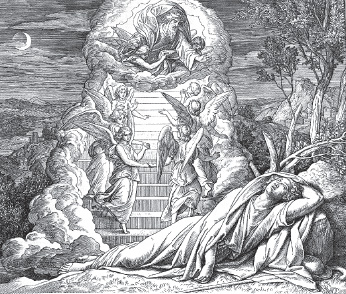
Jacob ascends into the Otherworld thanks to a ladder.
This seemingly innocuous parable conveys a wealth of information to anyone versed in the symbolic language of the Mysteries. The stone used by Jacob for a pillow and raised upright is known throughout Europe as a betyl or betilo; in Celtic lands it is menhir, in India Sivalingam, and all such megaliths are said to contain or house the energy of a natural or godly force. They also share another aspect: they all mark the intersecting paths of the Earth’s telluric pathways of energy,13 the very forces capable of inducing altered dream states.
Whether Jacob’s story is historically accurate or plain myth is beside the point. What is important is that it conveys a valuable lesson: that a person who interacts in a meditative manner with a hot spot of energy is capable of experiencing the Otherworld, and where such special places occur on the surface of the Earth they are commemorated by an upright stone, a passage mound, a temple, a pyramid, a dolmen, or a stupa.
It is also significant that the town where the story takes place, Harran, just happened to be the home of the Sabeans (from saba‘ia, meaning ‘wise or star people’), an esoteric sect known to have indulged in secret initiation ceremonies, one being an annual pilgrimage to the pyramids of Giza, because the Sabeans claimed the buildings brought them into proximity with the stars, not unlike Jacob’s own journey into the Otherworld.
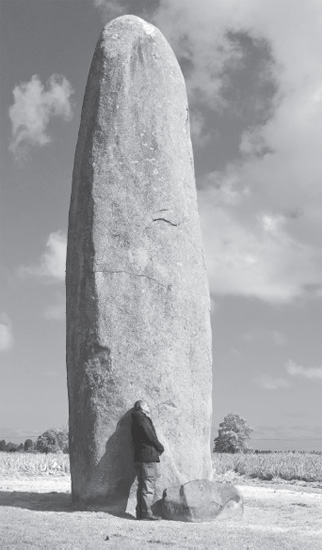
A small menhir. Dol, France.
ALL ONE GEEZER?
Which brings us to Giza’s namesake, Gisors, a town in northern France featuring a most unusual church dedicated to Saint-Gervais-Saint-Portais, whose ground was consecrated in 1119, the very year the Knights Templar came into existence—officially, at least.14 As it happens the church is intimately connected with the knights, as is an adjacent conical mound, itself a sacred site up until Roman times.
During the Second World War the Luftwaffe bombed Gisors. One blast near the church opened a hole into a crypt. Dedicated to St. Catherine, patron of the Templars, this room was rumored to have been part of the knight’s bridal chamber rituals. Excavations in the 1960s proved the existence of a passage linking this underground room with the nearby artificial mound and its own subterranean chamber, which at one point was accessed by a kind of well that appears designed not to draw water. Who created this elaborate engineering project and why is a matter of speculation. However, it is known that Gisors has, since the fourteenth century, been thought to be one repository of the Templar treasure, part of which was temporal—they had by then amassed huge financial wealth—while the other was spiritual in nature, a secret related to a ritual zealously guarded by the knights.15
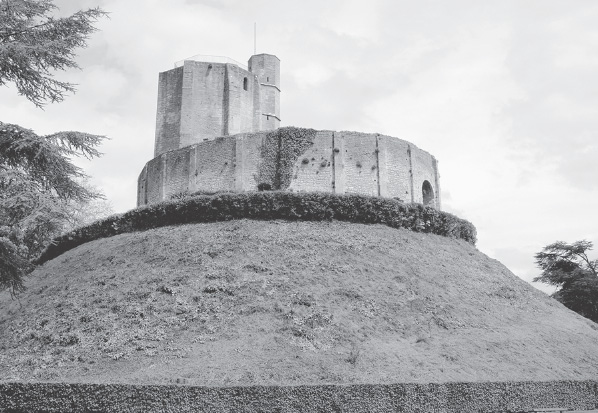
Mound and Templar castle. Gisors.
Evidence shows the Templars consisted of two very different groups: a general brotherhood that took care of temporal matters, and a selective inner brotherhood that conducted its affairs more like a ministerial college. One of the functions of the latter was the enactment of a ritual of raising the dead. Knights wishing to be admitted into this selective group even swore an oath of secrecy that contained the phrase, “I, wishing to come into the joys of Paradise . . .”
Hardly the kind of vow one makes to become a warrior!
In this, the ritual, the church, and the mound at Gisors are all linked. It is feasible that candidates would have been prepared for initiation in the crypt—one of many discovered beneath Templar places16—then led along the connecting passage to the bridal chamber beneath the sacred mound where they would journey to the Otherworld before being roused to greet the sunrise on the summit. To anyone who’s experienced similar environments—the Pyramid of Unas, for example—this processional format is all too familiar. But the big clue that this actually took place in Gisors is found in the most unusual tympanum above the church’s main entrance, for it depicts, in no uncertain terms, Jacob and his ladder, as though identifying this sacred place as a gateway into the Otherworld.
Hearing the name Gisors, it is impossible to deny the audible similarity to Gesu, an original spelling of the title Jesus. As it turns out, the names Gisors, Gesu, Jesus, and even Osiris are related.
Gisors is a corruption of the Basque term geezer, ‘a man who comes from afar or in disguise,’ whose origin appears to precede Christianity.17 It is unlikely the town was named for a simple stranger traveling from a distant place, but an exalted person journeying to and from another dimension, now that would be an event worth commemorating.
Geezer/Gesu/Jesu/Jesus bears a long etymological, historic, and geographic fingerprint. Its variants are gaesa, a Celtic oath or taboo (‘sacred, forbidden’); gusi, the cult of ancestral spirits followed by tribes in Borneo; ge-ez, the Ethiopian term for self-awareness; aiza, the guardian of the sacred shrines of Dahomey, and so on. These spiritual qualities then became the foundation of titles given to rulers representing the concept of the resurrected god-man. Examples include Gesar of Ling, a savior-god of Tibet circa 2500 BC who descended from heaven, slept in a cave, and restored order to the world; Jizo, a Japanese bodhisattva circa 1200 BC who built pyramids, assisted others on the path to enlightenment, was raised from the dead, and presides at the Temple of Ise; Geser Khan, sun king and epic hero of Mongolia; Esus, atoning god-man of Gaul circa 800 BC, crucified with a lamb at his side, and honored by the Canutissi (followers of Isis); Hu-Esus, Celtic god born of a virgin, prince of the Otherworld; Iasius, young Cretan god who lay in a field with Demeter; Eshu, Nigerian god who brought heavenly knowledge; Iasar, the same in ancient Phoenicia; and finally (but not exhaustively) the European titles for exalted ruler—whether they deserved the epithet or not—czar, kaiser, and caesar.
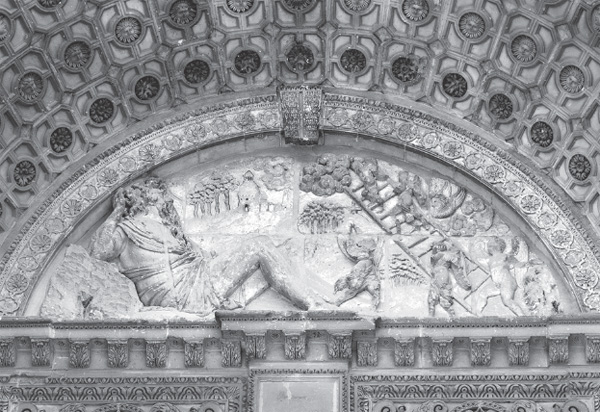
Jacob’s ladder on the tympanum of Gisors church.
So the resurrected god-man Jesus isn’t just one guy but many, and far older than two thousand years. In fact the story of a child divinely conceived by a virgin, often son to a carpenter, who is saved from death in infancy, retires for a prescribed time to a wilderness in a sequestered location, undergoes a major suffering or death as an act of atonement, crosses into the Otherworld for three days to meet with discarnate spirits while his physical body remains incorruptible, then resurrects, becomes an example of a perfected individual who’s deified as a god-man mediator, redeemer, intercessor, or messiah, is prevalent in most ancient religions and pagan traditions preceding Christianity.
The god-man savior of the Maya, Kukulkan/Quetzalcoatl, was born of a virgin mother, indulged in a forty-day fast on a sacred mountain, atoned, rode an ass, and was purified in a temple with water and anointed with oil. Then, according to the Codex Borgianus and Codex Vaticanus, he was nailed to a cross on a sacred hill and crossed into the Otherworld for three days before resurrecting, after which he held the attribute Morning Star.
Similarly, Krishna—who was accepted as a real person as well as a god—was born in cave, saved from death in infancy, taught in a forest, and returned to be nailed to a tree in the shape of a cross, and was resurrected. There are 346 analogies between the story of Christ and Krishna alone.18 Jesus’s story gets even more riveting if we look at the origin of that other master of living resurrection, Osiris.
Osiris is actually a Greek translation of the Egyptian Asar. When Asar inherits the earthly kingdom he is united with his heavenly father Geb, so his name takes on the grounded form Gasar (‘prince of the earth’). Gasar was also one of the original spellings of Giza, the others being Gesa, and Gesu, an original spelling of Jesus.
Giza represents the consummation of the sacred marriage between Gasar and Isa—Osiris and Isis—and the location where the two become one is the bridal chamber, otherwise known as the King’s Chamber of the Great Pyramid, that vast edifice and portal into the Otherworld.
Not bad for a geezer who came from the nasoraiyi.